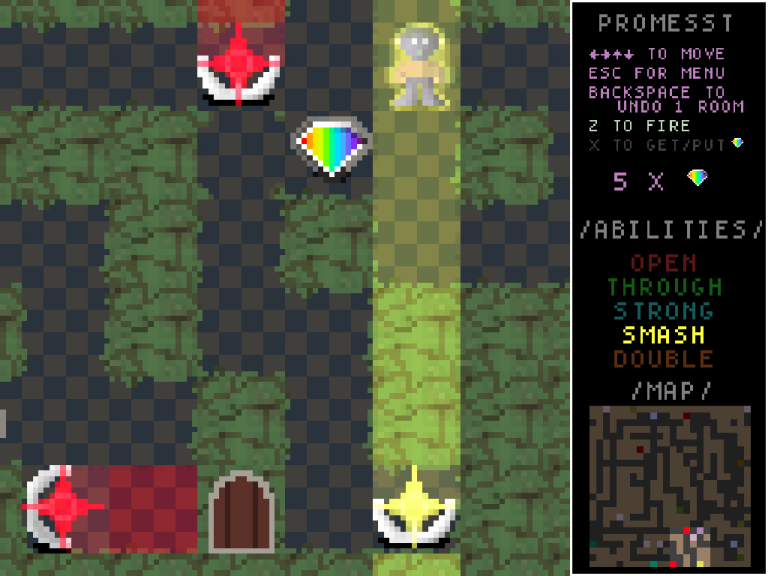
Promesst is a puzzle game by Sean Barret. I don’t like it. It’s still worth playing and writing about though.
Let me start by mentioning different game made by different person. Near the end of 2012 Michael Brough released freeware puzzle called Corrypt. I’ll slightly spoil it here, without being too specific. Corrypt puts sokoban style puzzles in a weird and glitchy lo-fi world. The first half is not that unconventional, but at some point the game turns into something else. When it happened, I had this sense of security and familiarity with the game - that moment takes it all away. The game builds up trust and abuses that for dramatic effect, it’s quite spectacular.
Promesst is a homage to Corrypt. It shares the same structure, very similar art style, both names are misspels of a word. However, it lacks something intangible that Corrypt has.
The main puzzle mechanic of Promesst is very smart. You turn on differently colored light beacons by placing gems into socket. Standing in the light gives player abilities corresponding to the color - red lets you open doors, yellow let’s you smash boulders and so on. Light beams are blocked by doors, boulders and gems, but go through wals. More often than not a beam will go out of screen bounds into neighbouring “rooms”. There’s no rooms really, just one connected space of 4x4 screen - games tries to solidify that by always shoving a sliver of neighbouring screens. This property of light to go until it hits something really brings the game together - it doesn’t have separate puzzles, everything is mingled and interconnected together. That also makes the game quite hard to enjoy.
At any point, you can only see 1/16th of the world and the type of puzzles that Promesst has makes you desperately want to see everything at once. I’m sure it would be easier to solve then, but also more fair. Now I’m supposed to resort to my memory to notice a particular beam which, when turned on, would be just where I need it three screens below. What often happens instead is just stumbling around in circles until I notice a particular combination of beams which I haven’t tried yet.
Oh, but I shouldn’t focus on the first part too much. It’s not too hard to solve, even if a bit annoying. Once you have 8 gems, game presents you with a zap gun! It’s that same moment from Corrypt, it turns structured and tidy puzzle game into a glitchy and scary one. I guess it would have been much more dramatic if I didn’t know what to expect, but c’mon, this is a homage game, mostly everyone playing it would have tried Corrypt already.
This last part was the most frustrating. I couldn’t just try out everything - now it actually matters to think before you act, you can get yourself into unsolvable states otherwise. And my visual memory just cannot fit the whole map, especially with so many moving and changing parts.
Interestingly, Sean Barret admits that he doesn’t enjoy Corrypt style twists. I don’t want to look into that too much, but at some points while playing I could almost feel it. Could it be then that the actual design is supposed to be frustrating? It would be a great way of showing how designer feels about such puzzles, by making hyperbole out of it. Just something to think about.
Let’s not forget one last thing - the most beautiful and important puzzle in Promesst is something that is very easy to miss. It happens before you start the game and only a single person in the world had a privilege of enjoying it. That puzzle was designing Promesst, arranging everything just the way it is. I’m sure Sean had a great time doing it and it shows - even with its flaws, great care was put into this game. The whole mechanism of switches, corridors, beams and boulders is intricate and amazing to play with.
Now, there is Promesst 2, which promises to be an even more difficult sequel. I wasn’t ready to play it yet, so soon after the original. I will try it one day, fully expecting it to be just as inspiring as the original.